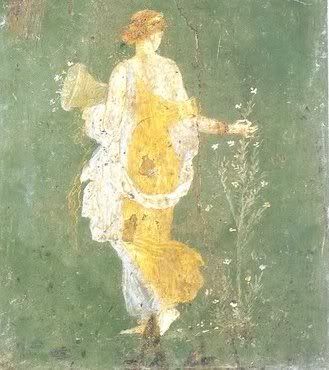
Flora Fresco, Castellammare di Stabia, Varano Villa Arianna
First Half of the First Century C. E.
Today is May Day. Even though spring officially begins in March, today is the day that celebrates the height of spring, a day of spring festivities and celebrations.
Like many of our modern holidays, May Day has its roots in ancient, pagan celebrations.
Beginning in the third century B.C. in Rome, the festival Floralia, for the goddess Flora, was held in the days around May Day, April 28th to May 3rd. Flora was a goddess of flowers and fertility, and the festival was held to please her so that she protected flowers and other blossoming plants. There was a circus and theater performances, there were prostitutes and naked dancers, and a sacrifice to the goddess. Deer and goats were let loose to symbolize fertility, and beans and lupines were scattered for the same reason. Romans usually wore white tunics, but during Floralia, they got to wear bright colors. Although Floralia wasn't instituted until the third century B.C., it evolved from an ancient celebration of spring and fertility traditionally held at that time. Ovid wrote: "Mother of flowers, Flora, present be, / We raise the chant midst jocund games to thee. / Begun in April, unto May deferred, / For both are thine, the jocund song is heard. / Upon the confines of both months we stand / Embellished with the bounties of thy hand."
In the Celtic British Isles, May Day was celebrated as the festival of Beltane, or Bealtaine or Bealtuinn — Bel was the Celtic god of light, and taine or tuinne meant fire. It was the summer half of the year — a time when the sun set later, when the earth and animals were fertile. Beltane lasted from sundown the night before to sundown on the first of May. On the eve of Beltane, people lit bonfires to Bel to call back the sun. People jumped over the fires to purify themselves, and they blessed their animals by taking them between bonfires before leading them to their summer pastures the next day. It was a day to walk around the property lines and assess your land for the summer season, to mend fences. Women washed their faces with the spring dew so that they would stay beautiful, and there was dancing, tournaments, parades, feasting, and general revelry. There were lots of flowers — men walked around the fires with rowan branches to keep evil spirits at bay, and May trees, or Maypoles, were set up covered in rowan or hawthorn flowers as a blessing. People danced around the Maypole, seen to be a phallic symbol to promote fertility, and villages would compete with each other to see who could produce the tallest maypole. Young couples went off into the forest to spend the night together and came back the next day with flowers to spread through the village. A young woman was crowned May Queen, and she would ride naked on horseback through the village.
Many of these celebrations continued as late as the 17th century — the Puritans were not too pleased, especially since so many young women went off into the woods and came back pregnant. Maypoles were made illegal in 1644.
Since the Puritans discouraged May Day, it was never a major holiday in America. Eventually it was reinvented as a holiday for children, with flowers and candy. And elements of it — rabbits for fertility, colored eggs (also for fertility), which had been scattered around the Maypole — were incorporated into Easter traditions. But May Day has its followers in America. The largest May Day celebration is in Minneapolis, where up to 50,000 people turn out for puppets, dancing, and music in a joyful community parade and a ceremony calling back the sun, put on by In The Heart of the Beast Puppet Theater with the help of about 2,000 volunteers.
(Thanks to Garrison Keillor for above quotation)



